| |

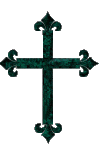

The Nombre De Dios Mission was established when
Menendez kneeled down to kiss a wood cross presented to him by Father Francisco
Lopez de Mendoza Grajales...a chaplain on the expedition. It was on these
grounds that Lopez would celebrate the first parish Mass in the new world
and begin the work of America's first mission. The Spanish seen this site
as a sacred spot afterall it was where Menendez and his men's ships
touched it shores and the founding of St. Augustine had began which is
America's oldest city in 1565.
In 1615 a chapel was built on the site which
would house 200 parishioners and by that time the Timucuan Indians were
attending here singing songs in the Latin language. They called the Chapel
Our Lady Of La Leche which sadly fell three times due to war, pirates, and
terrible storms. The last reconstruction of it began in 1918. It was made
to look much older then what it is today but the site it stands on is definitely
500 years old. This spot would be an area made for the devotion of Our
Lady Of La Leche to the Spaniards.
Nearby was the Rustic Altar the site outdoors
where a great feast was held between Lopez, Don Pedro Menendez De Aviles,
Adelantado Of Florida and Captain General Of The Indies Fleet, His
Colonist, Soldiers and Timucuans. They called this feast thanksgiving
similar to the Pilgrims...Menendez held it for his fleet and native Americans
who were living on these shores the same day of his arrival and thus the
first Christian settlement was born in the country. I have a
different take on it all though I believe that when the fleet came that
they forced these Native Americans to Catholicism and back then the
penalty for not submitting would be pillage, death, rape, abuse...etc
perhaps making this one of the bigger religious conspiracies in the nation
on how Christianity really came to be in the new world!
Archaeological expeditions have shown that the
site was part of a village, fort, and even burial ground. Of course today
a beautiful cemetery and the Menendez Coffin are on the grounds. The
cemetery has 6 federal soldiers buried here from the civil war,
parishioners of the church, Sisters
Of St. Joseph's, and some other well known residents of St.
Augustine. Even though the history below says the graves start from the
1800s I did find a few from the 1700s and their are probably even older
ones then that...that were unmarked when the community had no
cemetery. I found out the reason why I could NOT find the Menendez
Coffin was that its kept locked up inside the Shrine Gift shop. I spend a
long time running around like a chicken with its head cut off but during
looking for it I did encounter many beautiful sites along the way.
All the sites you see below I visited on this
investigation its a big area that has paths leading to various places...as
it sits right on the water. One could imagine a fleet of ships approaching
this place as the natives watched in curiosity. Its a great site with the
cemetery.....chapel...and historical signs. Its a very old site probably
very haunted to but that is not always my objective to prove a site is
haunted sometimes its just to let others ponder on it. The history more in
depth of each location is below along with the photos from my wonderful
journey through this place. It is one of the most gorgeous locations I
ever investigated and now I bring it to you! I have put the photos from
each area under each piece of history so you can get an idea of what each
location looks like to go with it!
©
By
Lord
Rick
Nombre
De Dios Site
From: http://www.missionandshrine.org/
Since
1993, the University of Florida has made significant strides in unearthing
some of the most important findings in St. Augustine’s history. This
work, conducted on the Mission grounds, has led to evidence of one of the
earliest, if not the earliest, Spanish fortifications in Florida.
The following text, prepared by Dr. Kathleen Deagan, Curator of the
Florida Museum of Natural History and Archaeology as well as professor of
Anthropology at the University of Florida, appears on a sign located
between the Mission chapel and the Rustic Altar:
A collaborative project of the Florida Museum of
Natural History, the Florida Department of State, the National Geographic
Society, and the Catholic Diocese of St. Augustine.
On September 8, 1565, Pedro Menedez de Aviles of Spain landed near here
and claimed Florida for the Spanish Crown. He built the first Spanish fort
in Florida by fortifying the Chief’s house at the nearby Timucua Indian
town of Seloy.
Archaeologists from the University of Florida have recently discovered the
moat from a sixteenth-century Spanish fort believed to be that of Menendez
on the grounds of the Nuestra Senora de la Leche Shrine (Mission of Nombre
de Dios). Excavations are underway to uncover it and study the remains of
some of the earliest European presence in what is now the United States.

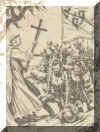

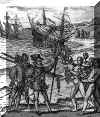

Our
Lady of La Leche Chapel & Cemetery
From the Great Cross area and its expanse of open space and sunlight, you
will follow the path to the chapel of Nuestra Senora de la Leche y buen
parto (Our Lady of the Milk and Happy Delivery) under a canopy of oak and
cedar trees. This area is often referred to as “America’s Most Sacred
Acre.” Commonly referred to as the chapel of Our Lady of La Leche, the
Spanish style chapel invites you to spend some time in prayerful
reflection.
Considering that coquina stone was not used for construction until well
into the seventeenth century, we surmise that the earliest chapels were
made of wood. These early chapels would have been susceptible to fires and
hurricanes.
History records that when British Colonel John Palmer, a member of the
Commons House of Assembly in South Carolina, attempted to subdue St.
Augustine in 1728, the chapel of Our Lady of La Leche was built of stone.
The Spanish fired at the chapel from the Castillo de San Marcos, to
prevent Palmer from using the building to benefit his attack on the city.
Bishop Augustin Verot, first Bishop of the Diocese of St. Augustine,
rebuilt the chapel in 1875. Shortly thereafter, it was severely damaged by
a hurricane. Bishop Michael Curley, who later became Archbishop of
Baltimore, began the present restoration of the chapel in 1914.
The present chapel is small and simple, holding approximately thirty
persons, and reflects the Spanish mission style of the sixteenth century.
The chapel houses the statue of Our Lady of La Leche and is a special
place of quiet prayer for those seeking Our Lady’s intercession. A
statue of St. Peter, holding the keys of the kingdom, stands above the
outside entrance and below a small mission bell.
Circumstances permitting, Mass may be celebrated in the chapel on Tuesdays
at noon. The rosary and other devotions are often held in the chapel. Many
visitors purchase candles from the nearby Shrine Gift Shop and place them
in the chapel in order that their prayers may continue beyond their visit.
Memorials in this area include a rustic altar commemorating the first Mass
celebrated here, a statue of St. Francis of Assisi recognizing the work
and sacrifices of the Franciscan missionaries, a statue of St. Joseph, a
bell tower, a fountain, several religious plaques, and monuments of the
seven sorrows of Mary. In this same area are numerous tombstones dating
from the 1800’s, including those of some of the founding Sisters of St.
Joseph.




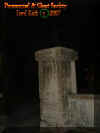
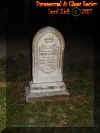
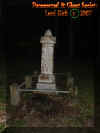
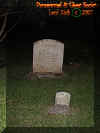
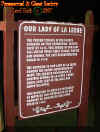
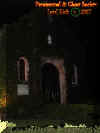
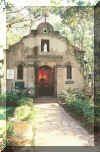




















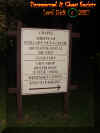
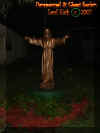
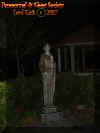
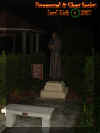
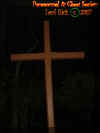
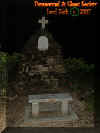
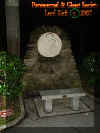

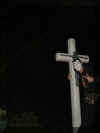

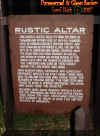

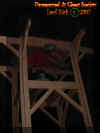

Our
Lady Of La Leche Shrine
Located
at the center of the tranquil grounds of the Mission of Nombre de Dios is
the chapel which houses a replica of the statue of Our Lady of La Leche
and provides visitors with a quiet place to pray.
Our Lady of La Leche is the first shrine dedicated to Our Blessed Mother
in the United States. The history of the devotion to the Mother of Jesus
as Our Lady of La Leche may have roots in a 4th Century grotto in
Bethlehem. To this day the Franciscan community maintains a shrine there
called the Milk Grotto. Its centerpiece is the Blessed Virgin nursing the
infant Jesus. Many believe that the crusaders brought the devotion to Mary
as a nursing mother to Spain in the Middle Ages.
During the reign of Phillip III in Spain, word spread of a nobleman’s
wife and baby, expected to die during the birth of the child, who were
both spared as a result of the intercession of Nuestra Senora de la Leche
y buen parto (Our Lady of the Milk and Happy Delivery). The statue, in
possession of the nobleman, soon found a place in the hearts of many
throughout Spain.
By the early 1600’s the devotion, under the title of Nuestra Senora de
la Leche y buen parto, had a special place in the lives of the Spanish
settlers and the converted Native People in St. Augustine. It was on these
same Mission grounds that the Spanish built the first Marian Shrine in the
land, a devotion that continues to this present day.
Thousands of visitors and pilgrims make their way to the Shrine every
year. Many ask for the blessings of motherhood, beseeching the
intercession of Our Lady of La Leche that God will grant them a safe and
happy delivery, and healthy, holy children. Many write requesting
remembrances in Masses and prayers not only for motherhood but for
petitions of all kinds. All who visit the Shrine find it to be a place of
spiritual comfort and renewal.

The
Great Cross
This
massive structure, made of stainless steel and rising two hundred and
eight feet above the marshes of the Matanzas River, stands as a sentinel
over the Mission and a “Beacon of Faith” for all who pass this way.
It was erected at the direction of Archbishop Joseph P. Hurley, then
Bishop of the Diocese of St. Augustine. His Excellency Casimiro Morcillo,
Archbishop of Madrid, dedicated it during the diocesan Eucharistic
Congress of October 1966. Like the Prince of Peace Church, the Great Cross
celebrates the Four Hundredth anniversary of the Mission of Nombre de Dios
and the City of St. Augustine.
Four hundred years earlier, in 1565, Pedro Menedez de Aviles placed a
small wooden cross in Florida’s soil and founded the Mission of Nombre
de Dios. The beginnings of Christianity in this new land led to numerous
missions throughout Florida and, eventually, to the flourishing of the
faith that we celebrate throughout this country. The Great Cross is a
tribute to that growth. It serves to remind the visitor of Christ’s
ultimate sacrifice on the Cross, as well as the role played by the
Catholic religion in the history of both Florida and our Nation.
The Cross weighs 70 tons and consists of 200 stainless steel panels in
various sizes. The loftiest sections of the Cross contain 1.6 ft. x 10 ft.
panels 3/16 in. thick, while 4 ft. x 10 ft. and 5/16 in. thick panels
cover the foundational sector. To prevent potential damage from hurricane
force winds, workers solidified the lower 65 feet of the Great Cross by
tightly filling the inside with concrete. At night, lights mounted from
the ground provide illumination of the Great Cross.
The base of the Cross is made of granite slabs. Several of the slabs have
names inscribed as memorials from family or other loved ones. Information
regarding such memorials is available through the Mission office: (904)
824-2809 or (800) 342-6529.

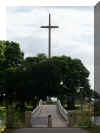

Our
Lady Of Guadalupe Shrine
Next
along the path, the Shrine of Our Lady of Guadalupe is a gift from friends
of a distinguished modern day missionary in Brazil . This shrine, in
colorful Spanish tiles, commemorates the 1531 visitation of the Blessed
Virgin Mary to St. Juan Diego in Guadalupe, Mexico. Below is an
abbreviated version of the marvelous event.
At dawn on December 9 in Tenochtitlan, now Mexico City, a native named
Juan Diego was walking across a hill called Tepeyac when he suddenly heard
birds bellowing gleeful music in the distance. He then heard a voice
calling him, and as he wondered to himself what was happening to him, he
saw a beautiful woman. She instructed Juan Diego to tell the bishop to
build a church on that very spot. Soon realizing that the lady was indeed
the Virgin Mary, he responded and did what she implored of him. After
being rejected by the bishop, Juan Diego, ready to give up on his task,
was approached again by the Virgin Mary. She reassured him that he alone
was to be her messenger.
Juan Diego again visited the bishop, but after a second refusal by the
prelate, he was instructed to attain proof of Mary’s visitations. On the
third visit from the Holy Mother, Juan Diego surprisingly found roses on
the Tepeyac hill in spite of the frost-covered landscape. He picked the
roses and placed them inside his cloak, as proof of her presence. Juan
Diego returned to the bishop and opened his cloak. The precious image of
Mary then appeared impressed on the tough cloth. The bishop, who had now
experienced the glory of which Juan Diego had spoken, built the church.
Within six years of the apparition, over six million Aztecs converted to
the Christian faith.
The image remains intact on St. Juan Diego’s original cloak and is
preserved in the cathedral in Guadalupe, Mexico. Millions of pilgrims from
all over the world visit the cathedral to pray for healing and renewal.
On the tiled replica of the original image of Our Lady of Guadalupe here
at Nombre de Dios one will note symbols that were quite familiar to the
Aztec natives. For example, the black ribbon symbolizes “woman with
child.” The rays of the sun are seen around her body, signifying that
Mary is more powerful than the Aztec’s “sun deity.” Similarly, the
Aztecs worshipped the moon as a deity; however, in the image, the sacred
mother has the moon beneath her feet. Seeing such a depiction would have
fed the Aztec’s curiosity about the mother’s child and his importance
to the world. Christ had become real to the Aztec people and helped
transform their lives through this marvelous image.
For more information on Guadalupe and guidance in devotion to our Blessed
Virgin Mary, go to: www.sancta.org
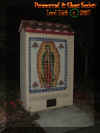
Father
Francisco Lopez de Mendoza Grajale Statue
Following
a guided or self-guided tour from the Prince of Peace Church, you will
cross the Michael Gannon bridge over a picturesque lake. A bronze memorial
stands on the lagoon’s eastern band. This impressive bronze statue of
Father Francisco Lopez de Mendoza Grajales, chaplain of Menendez’ fleet;
celebrant of the first Mass here; and first missionary at Nombre de Dios,
stands eleven feet tall on a large base. Set on fossilized coral from the
bottom of the Atlantic Ocean, the base is made of sturdy granite of a dark
green hue.
In a diary, Father Lopez recorded the September 8, 1565 landing of Don
Pedro Menendez de Aviles, Captain General of the Indies Fleet and
Adelantado of Florida at the village of Seloy:
On Saturday the 8th, the General landed with many banners spread, to the
sounds of trumpets and the salutes of artillery. As I had gone ashore
the evening before, I took a Cross and went to meet him, singing the
hymn, Te Deum Laudamus (Latin for We Praise You God). The General,
followed by all who accompanied him, marched up to the cross, knelt, and
kissed it. A large number of Indians watched these proceedings and
imitated all that they saw done.
Menendez then named the site Nombre de Dios (Name
of God) and set Father Lopez in charge of the Mission. Father Lopez thus
became the first pastor of St. Augustine, the first parish priest in this
land. The artist, a native Croatian, Dr. Ivan Mestrovic, intended the
rough texture of the surrounding area to signify the tumultuous journey
taken by the Spanish to America and to memorialize those who perished on
the journey. Dr. Mestrovic's statue portrays Father Lopez in priestly
vestments preaching the Gospel. The statue was dedicated on April 13, 1958
with Dr. Mestrovic and his wife in attendance. Dr. Mestrovic was Dean of
Art at Notre Dame University in South Bend , Indiana when he fashioned
this work. He is noted for several outstanding sculptures in many parts of
the world, including the Notre Dame campus and the Shrine of the
Immaculate Conception in Washington D.C. Dr. Mestrovic found special
significance in the passion of Father Lopez and his fellow priests to
endure the journey to Florida and bring the message of Christ to the
native peoples, so Dr. Mestrovic expressed their powerful story through
this touching statue found here. To learn more about Dr. Mestrovic and his
work, go to: www.mdc.hr/mestrovic
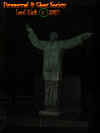
Prince
Of Peace Church
A beautiful fountain graces the
circled entrance to the Mission grounds. To the right of the circle is the
Prince of Peace Church. The church was built in 1965 to commemorate the
Mission’s Four Hundredth anniversary. Prince of Peace is a votive church
dedicated to prayers that God would deliver the world from atomic warfare.
Similar
to the Castillo de San Marcos (1672), a mile north of the Mission grounds,
the Prince of Peace Church is composed mostly of coquina stone (a natural
rock formation consisting of limestone and small particles of broken
seashells which form a strong building material). Like the Castillo, the
walls of the church are composed of solid blocks of coquina stone rather
than a mixture of coquina dust and cement seen in other constructions.
This solid construction reminds the visitor of the strength of the
Christian faith and prayer in the face of adversity.
This
shrine, farther northwest on the path, consists of a beautiful mosaic of
Our Lady of Perpetual Help housed in a Byzantine styled cupola. The
imagery of this gold-laden mosaic icon displays Mary’s contemplation on
the God-child of whom she is the vessel of honor. The cupola itself is
known for its simplicity, appropriate as the holy abode for the humble
Mother of Christ.
Byzantine Rite Catholics, like Roman Catholics, share the same faith and
doctrine of the Catholic Church. Both are united under the leadership of
the Pope in Rome. Over two hundred Byzantine Rite Catholics attend the
bi-annual pilgrimage to the Mission of Nombre de Dios to visit the Shrine
of Our Lady of Perpetual Help. The parishes of the Passaic Southern
Deanery Diocese stretch from Miami, Florida to Passaic, New Jersey. The
faithful pilgrims in the Passaic Diocese gave the icon replica to the
Mission of Nombre de Dios as a gift of charity on October 1, 1988.
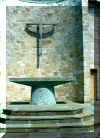
Our
Lady of Perpetual Help Shrine
The original portrait of Our Lady of Perpetual Help (or Succour) elegantly
painted on wood first appeared in San Matteo in Rome, but the French
invaded Rome in 1812 and destroyed the church. Rediscovered by the general
public again in the early 1860’s at an Augustinian oratory, Pope Pius IX
then ordered that it be venerated once again for the world to see at St.
Alphonsus Church, built near the ruins of San Matteo where it now resides.
Our Lady of Perpetual Help presents a portrait of the Blessed Virgin
holding Christ in a loving, matriarchal embrace. Fixed above Jesus and
Mary both crowned in glory, the Archangels Michael and Gabriel offer
Christ the objects of his Passion as Mary mothers Jesus by coming to his
aid when his sandal has come off. Looking more intently at the portrait,
one notices Greek abbreviations translating to Mother of God, Jesus
Christ, Archangel Michael, and Archangel Gabriel.
To be sure, the Byzantine rite and the Latin rite both draw inspiration
and devotion to Mary from scripture, the main instance being Luke 1:46-55.
Both sects incorporate this passage known as the Magnificat to Roman
Catholics and to Eastern Catholics as the Canticle of Mary into their
liturgical year:
And Mary said:
“My soul glorifies the Lord and my spirit rejoices in God my Savior,
for he has been mindful of the humble state of his servant. From now on
all generations will call me blessed, for the Mighty One has done great
things for me -- holy is his name. His mercy extends to those who fear
him, from generation to generation. He has performed mighty deeds with
his arm; he has scattered those who are proud in their inmost thoughts.
He has brought down rulers from their thrones but has lifted up the
humble. He has filled the hungry with good things but has sent the rich
away empty. He has helped his servant Israel, remembering to be merciful
to Abraham and his descendants forever, even as he said to our
fathers.”
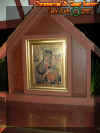
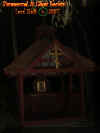
|
|






























































